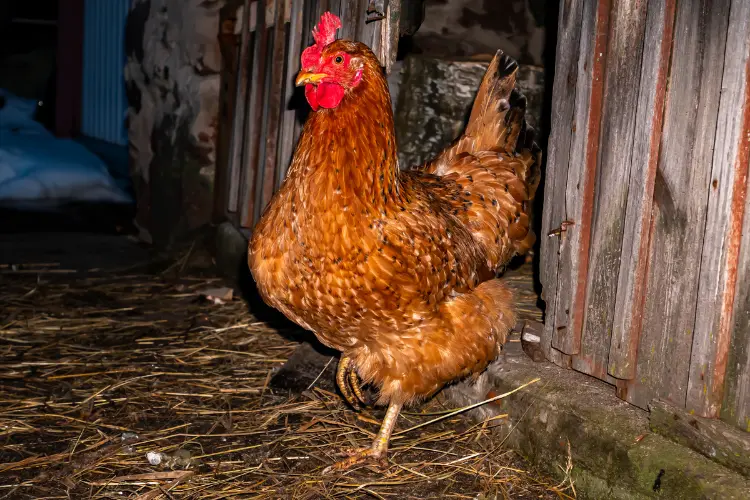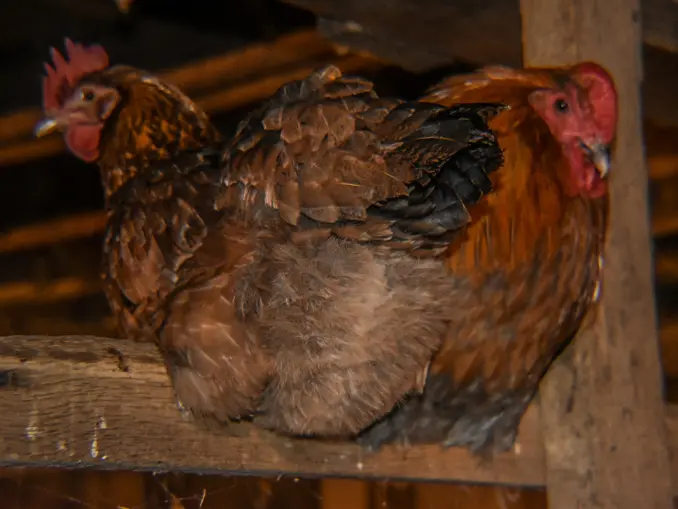How To Train Your Chickens to Go Into the Chicken Coop at Night
For poultry keepers, ensuring the safety and well-being of their feathered friends is a top priority. When night falls, chickens naturally seek shelter from potential predators and the elements by roosting in their coop.
However, getting your chickens to voluntarily return to the coop at dusk isn’t always as straightforward as it sounds.
If you’ve found yourself chasing after stubborn hens or coaxing reluctant roosters into their coop each evening, you’re not alone. Fortunately, there are effective techniques and strategies for training your chickens to go into the coop at night, making your life as a chicken keeper easier and your flock safer.

Visual Capabilities of Chickens
Chickens possess a fascinating set of visual capabilities that distinguish them from humans and many other animals. Their eyesight is exceptionally adept at perceiving color, exceeding that of humans by having four types of cones, allowing them to see a broader spectrum of colors, including ultraviolet light.
Chickens can also detect subtle variations in light and color shades, a crucial skill for foraging and detecting potential threats. Their unique eye anatomy, with three eyelids and the ability to independently move each eye , enables them to maintain a wide field of vision, approximately 300 degrees, without turning their heads.
However, one notable limitation is their inability to see in complete darkness; they lack night vision but can sense changes in light through their pineal gland, which helps them anticipate dusk and seek the warmth and security of the coop at night.

Why Chickens Need to Go in the Coop at Night
Chickens must go into the coop at night primarily for their safety and well-being. As the sun sets and darkness falls, chickens become highly vulnerable to various nocturnal predators, including foxes, raccoons, owls, and coyotes.
Due to their limited ability to see in low-light conditions or complete darkness, staying outside at night puts them at significant risk of being attacked or harmed by these predators.
The coop provides a secure and sheltered environment where chickens can roost and rest safely, protected from both predators and adverse weather conditions. It also aligns with their natural instincts and daily routine, as chickens have evolved to seek shelter and security as dusk approaches, guided by their innate sense of changing light levels through the pineal gland.

How To Train Your Chickens to Go Into the Coop at Night
Training your chickens to go into the coop at night is essential for their safety and well-being. Here’s a step-by-step guide on how to train your chickens to go into the coop at night:
Step 1: Prepare the Coop
You must ensure that your chicken coop is clean and in good condition. Provide appropriate bedding for your chickens to nest and roost comfortably. Make sure there are clean nesting boxes and ample food and fresh water inside the coop to meet their needs.
Step 2: Gradual Introduction
If you have young or new chickens, introduce them to the coop during the day when they are calm and less likely to be stressed. Allow them to explore the coop at their own pace without any pressure or force. This helps them become familiar with their new environment.
Step 3: Establish a Routine
Chickens thrive on routines, so it’s crucial to establish a daily schedule. Feed your chickens at the same time each day, preferably in the coop or run area. Consistency will help them associate the coop with a source of food and comfort.
Step 4: Late Afternoon/Early Evening Feeding
About an hour or two before dusk, provide a final feeding outside the coop or in the run area. This encourages your chickens to return to the coop voluntarily in the evening because they will associate it with the last meal of the day.
Step 5: Use Treats as Lures
Treats like mealworms, scratch grains, or other favorite treats can lure your chickens into the coop. Start by tossing some treats inside the coop, gradually moving closer to the entrance. This entices them to go inside.
Step 6: Patient Observation
As the sun begins to set and daylight fades, quietly observe your chickens. You’ll notice that they naturally start moving toward the coop as darkness approaches. Chickens have an innate sense of timing and will instinctively seek shelter as it gets darker.
Step 7: Encourage Roosting
Inside the coop, ensure there are comfortable roosts at an appropriate height for your chickens. Roosting bars or platforms should be higher than the nesting boxes to encourage them to roost at night, which is their natural behavior.
Step 8: Minimal Disturbance
Refrain any sudden movements or loud noises around the chicken coop during the evening hours, as this can startle your chickens and discourage them from going inside. A calm environment promotes a sense of security.
Step 9: Provide Adequate Lighting
Using a small, low-wattage light inside the coop during the evening can make it more inviting. Chickens can see better in dim light than in total darkness, which can help them feel safer when entering the coop.
Step 10: Repeat the Process
Consistency is key to training your chickens. Continue this routine consistently for several weeks until your chickens have established the habit of going into the coop on their own at night. Over time, they will associate it with safety and shelter.
Step 11: Close the Chicken Coop Door
After your chickens have gone inside for the night, close the coop door to protect them from predators. Ensure that the coop is securely locked to keep them safe until morning.
Read also: Best Automatic Chicken Coop Doors: Upgrade Your Coop Today

How To Train Your Chickens to Come To You
Training chickens to come to you can be a rewarding experience and is particularly useful for various reasons, including health checks, bonding, and ease of management. Here’s a step-by-step guide on how to train your chickens to come to you:
Step 1: Start with Trust and Patience
Before you begin training, ensure that your chickens trust you. Spend time with them regularly, feed them by hand, and speak to them in a gentle and calming tone. Building a positive relationship with your chickens is essential.
Step 2: Choose a Distinct Call
Select a distinct and consistent sound or word that will serve as your call. This can be a whistle, a specific word or phrase like “Here, chickens!” or any other sound that is easy for you to replicate consistently.
Step 3: Offer Irresistible Treats
Chickens are motivated by food, so use their favorite treats as a reward. Mealworms, scratch grains, or small pieces of fruit are popular choices. Ensure that the treats are something your chickens truly love.
Step 4: Establish the Call and Reward Connection
Begin in a quiet and familiar location, such as your backyard or chicken run. Make the chosen call and immediately present the treats. The key is to create a positive connection between the call and the reward. Do this several times during the training session.
Step 5: Encourage Approach
Initially, you may need to take a few steps toward your chickens as you make the call and offer treats. This helps encourage them to approach you. Gradually, you can reduce the distance you move toward them.
Step 6: Be Patient and Consistent
Training chickens takes time and patience. Repeat the process consistently during short training sessions. Keep the training positive and enjoyable for your chickens, avoiding any stressful situations.
Step 7: Expand Training Locations
Once your chickens respond well to your call in a familiar environment, gradually expand the training to different locations within your property. This helps reinforce their understanding that the call means treats and a positive experience.
Step 8: Use Hand Feeding
Whenever possible, hand-feed your chickens while calling them. This strengthens the bond between you and your flock and reinforces the idea that coming to you results in treats and attention.
Step 9: Reward Every Time
In the beginning, reward your chickens every time they respond to your call and come to you. As they become more consistent in their response, you can slowly minimize the frequency of treats, but continue to reward them regularly to reinforce the behavior.
Step 10: Be Patient with Individual Differences
Keep in mind that individual chickens may respond differently to training. Some may catch on quickly, while others may take more time. Tailor your training to the pace of each bird.
Step 11: Practice Regularly
Consistency is the key to successful training. Practice calling your chickens regularly to maintain their responsiveness.

Reasons Why Chickens May Come Into the Coop at Night
Hens have a natural instinct that drives them to return to the coop as evening approaches. This behavior is influenced by a combination of factors, including their innate sense of safety, routine, and biology.
As the day turns to dusk and light levels diminish, chickens rely on their keen sense of time and the changing light detected through the pineal gland to sense that nightfall is near. This signals to them that it’s time to seek shelter from potential nocturnal predators.
Additionally, chickens are creatures of habit, and they establish a daily routine that includes returning to the coop to roost and lay their eggs. This routine not only offers them protection from threats but also provides a familiar and secure environment for their nighttime activities.
Overall, it’s a combination of instinct, biology, and habit that motivates hens to return to the coop, ensuring their safety and well-being during the night.
Reasons Why Chickens May Not Come Into the Coop at Night
Chickens not returning to the coop at night can be attributed to several factors. Young and inexperienced chickens may not have developed the habit of going into the coop yet, as it takes time for them to recognize it as their safe haven.
Pest infestations within the coop, such as mice, rats, or red mites, can make the environment uncomfortable and uninviting, causing chickens to avoid it. The presence of predators, even if not detected, can trigger fear and reluctance to enter the coop, as chickens are highly sensitive to potential threats.
Additionally, within the flock, bullying and the pecking order can play a role, with lower-ranking or submissive chickens avoiding the coop to evade aggressive behaviors from dominant members.
Lastly, broody hens experiencing hormonal changes may choose to nest outside the coop, away from the roosting area, as they instinctively seek a more suitable spot for their brooding behavior.
Understanding these factors can help chicken keepers address specific issues and ensure their flock’s safety and comfort at night.
Ways To Help You Catch Your Chickens When Needed
1. Use a Poultry Pole
A poultry pole is a long pole with a hook or noose at the end designed to gently capture chickens. To use it, approach the chicken calmly and slowly, extend the pole gently over their back, and then lower the noose or hook over their head and neck. Be gentle to avoid causing injury or stress to the chicken.
2. Use A Landing Net
A landing net, often used for fishing, can be adapted for chicken catching. Approach the chicken cautiously and swiftly place the net over them, then carefully lift them up. Ensure the net is soft and not abrasive to avoid hurting the bird.
3. Use Cardboard Boxes
If you have trouble catching a specific chicken, you can try using a cardboard box to build a makeshift trap. Place some treats or food inside the box and wait for the chicken to enter. Once inside, gently close the flaps to contain the chicken.
4. Using a Stick with a Wet Cloth
This method involves using a stick with a wet cloth attached to one end. Gently approach the chicken and place the wet cloth near its feet. The sensation of the wet cloth on their feet may encourage the chicken to step onto the stick.
Slowly and carefully lift the stick, allowing the chicken to perch on it. This method is a gentle way to lift and transport chickens without causing stress or discomfort. It can be particularly useful when you need to move chickens from one place to another within a coop or run.
5. When Free-Range Becomes Too Much Freedom
If your chickens have too much freedom and are difficult to catch, consider limiting their access to a smaller enclosed area temporarily. This can make catching them easier when needed, and you can gradually expand their free-range space again once they become more accustomed to being handled.
Train Your Chickens Now
Training your chickens to go into the coop at night is essential for their safety and peace of mind for you, the poultry keeper. By following these steps and being consistent and patient in your approach, you can successfully train your chickens to seek the safety of the coop when darkness falls.
It’s a rewarding process that strengthens the bond between you and your feathered companions while ensuring their well-being. Happy chicken keeping.





